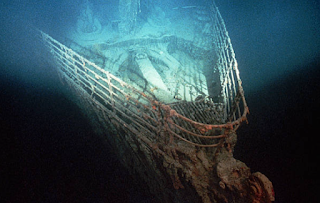 |
| Titanic Wreckage |
The Titanic was a British passenger liner that sank in the North Atlantic Ocean on 15 April 1912, after colliding with an iceberg during its maiden voyage from Southampton to New York. It was one of the largest and most luxurious ships of its time, carrying more than 2,200 people, including some of the wealthiest and most prominent figures of the era. The disaster claimed the lives of more than 1,500 people, making it one of the deadliest peacetime maritime tragedies in history.
## The Discovery of the Wreck
The Titanic remained undiscovered for more than seven decades, despite several attempts to locate it. It was finally found on 1 September 1985 by a joint US-French expedition led by oceanographer Robert Ballard and marine geologist Jean-Louis Michel. They used a remotely operated vehicle (ROV) called Argo to scan the ocean floor, and spotted the debris field of the wreck at a depth of about 3,800 meters (12,500 feet).
The discovery sparked a worldwide interest and fascination with the Titanic, as well as a controversy over its ownership, preservation, and exploration. Since then, several expeditions have visited the wreck site, using submersibles, ROVs, and divers to document, photograph, and recover artifacts from the ship.
## The Current State of the Wreck
The Titanic lies in two main pieces, separated by about 800 meters (2,600 feet). The bow section is still recognizable, with its grand staircase, anchor, and portholes intact. The stern section is more damaged and twisted, with its propellers, engines, and rudder exposed. A large debris field surrounds the wreck, containing thousands of items such as dishes, luggage, furniture, clothing, and personal belongings.
The wreck is deteriorating due to natural and human factors. The salt water, currents, bacteria, and marine life are corroding and consuming the metal and organic materials. The submersible visits and salvage operations are also causing physical damage and disturbance to the wreck. Some experts estimate that the Titanic could collapse or disappear within a few decades.
## The Latest Scan of the Wreck
In 2022, a new scan of the Titanic was created using deep-sea mapping technology. It was the first full-sized digital scan of the shipwreck, providing a unique 3D view of the entire ship as if the water has been drained away. The scan was carried out by Magellan Ltd, a deep-sea mapping company, and Atlantic Productions, who are making a documentary about the project. They used submersibles to take more than 700,000 images from every angle, creating an exact 3D reconstruction.
The scan shows both the scale and the details of the shipwreck, revealing new insights into its condition and history. It also shows some features that have never been seen before, such as the serial number on one of the propellers. The scan is expected to shed new light on exactly what happened to the Titanic when it sank in 1912.
## The Future of the Wreck
The Titanic is more than just a shipwreck. It is a cultural icon, a historical monument, a scientific treasure, and a memorial for those who perished in its sinking. It is also a source of controversy, debate, and ethical dilemmas. Who owns the Titanic? Who can visit it? Who can recover its artifacts? How can it be protected and preserved? These are some of the questions that still need to be answered.
The Titanic is also facing new challenges in the present and future. In 2023, a tourist submersible called Titan imploded on a deep dive to view the wreck, killing five people on board. It was one of the worst accidents in underwater exploration history. The incident raised questions about the safety and regulation of such activities.
The Titanic is also threatened by climate change and ocean pollution. The rising temperatures and acidity of the sea water could accelerate its corrosion and decay. The increasing amount of plastic and other debris in the ocean could also damage or entangle with the wreck.
The Titanic is a part of our collective memory and imagination. It is a reminder of our past achievements and failures, our hopes and fears, our dreams and nightmares. It is also a challenge for our present and future actions and responsibilities. How we treat the Titanic reflects how we treat ourselves and our planet.
Read also:-
Bhim Army Chief Chandrashekhar Azad Ravan Survives Assassination Attempt in UP
AIIMS Hospital Raebareli: A Medical Institute of National Importance
The Witcher Season 3: A thrilling and satisfying conclusion to Henry Cavill's saga